Anesthetic Machine Parts and Functions – Flashcards
Unlock all answers in this set
Unlock answersquestion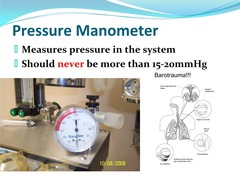
Pressure Manometer

answer
Indicates the pressure that is within the breathing circuit and the patient's airways/lungs. The pressure is normally zero
question
The maximum pressure per animal size is as follows
answer
Cats, rabbits, ferrets and small dogs - 8-10cm water Medium sized dogs - 12-15cm water Larger dogs - 15-20cm water
question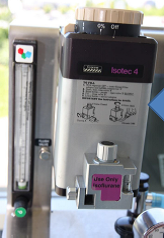
Vaporiser

answer
Contains the anesthetic gas in liquid form, which is converted to vapour as the oxygen flows through it. Precisions settings ensure that the proper percentage of anesthetic is delivered. Vaporizers use anesthetics such as isoflurane and sevoflurane.
question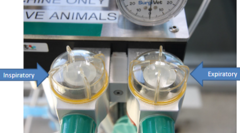
Flutter Valves

answer
Inspiratory and expiratory valves that ensure unidirectional flow of gases through the breathing circuit.
question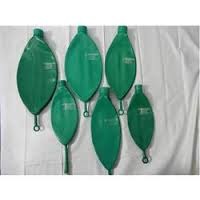
Reservoir Bag

answer
Acts as a reservoir of gases for the patient to breathe. The reservoir bag also expands and contracts allowing veterinary personnel to monitor a patient's respirations. This bag also allows us to manually ventilate a patient (sometimes referred to as "bagging" the animal). To determine the reservoir bag size for a patient use the formula 60mL/kg and round up.
question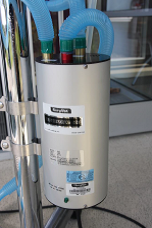
Scavenger canister

answer
The scavenger gets rid of the exhaled anesthetic and throws outside the building.
question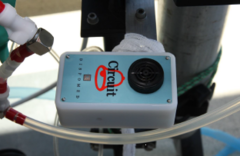
Pressure alarm

answer
Attaches to the fresh gas outlet and will emit a high pitched sound when the pressure within the system goes above 15 cm of water.
question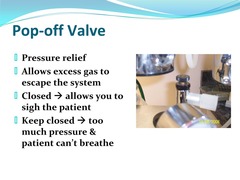
Pop Off Valve

answer
Maintains the normal operating pressure of the anesthetic system by allowing excess gas to exit from the anesthetic circuit and enter the scavenger.
question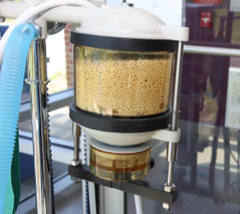
Soda lime canister

answer
Contains soda lime which absorbs the carbon dioxide and water vapour expired by the patient.
question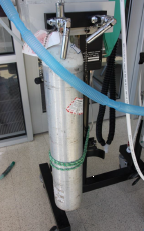
Oxygen tank

answer
Metal cylinder which contains oxygen at a high pressure (this high pressure allows a large amount of gas to be stored in a relatively small space). There are different sizes of cylinders including E (small; attach to anesthetic machine) and H (large, standing cylinder).
question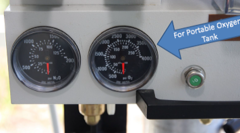
Tank Pressure Gauge

answer
Measures the pressure of a gas (in psi or kPa), such as oxygen, contained within a tank. The pressure in a full oxygen tank is about 2200psi.The pressure gauge will register zero when a tank is empty or when it is turned off and the line has been drained ("bled"). Oxygen tanks should not be used at pressures of 500 psi or lower.
question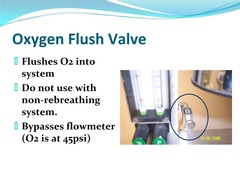
Oxygen Flush Valve

answer
Allows a large amount of oxygen to flood the anesthesia delivery system and, therefore, the patient. When this valve is opened, oxygen bypasses both the flowmeter and the vaporizer and is delivered to the patient at a rate of 35-75L/min. This valve is often used to quickly get oxygen to very ill patients, and when animals are being recovered from anesthesia (dilutes the anesthetic gas remaining in the breathing circuit).
question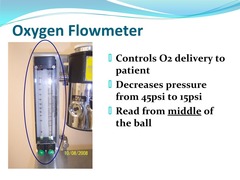
Oxygen Flow Meter

answer
Regulates the volume of oxygen supplied to the anesthetic system and to the patient. The amount of oxygen delivered to the patient is measured in L/minute. This volume is determined based on the size of the patient and the type of breathing circuit being used.
question
Pressure Reduction Valve (Pressure Regulator)
answer
Before the gas in a high pressure tank can enter an anesthetic machine, the pressure must be significantly reduced. The pressure reduction valve accomplishes this by lowering the pressure from approximately 2200 psi to a more manageable pressure of 40-50 psi.
question
Negative Pressure Relief Valve
answer
Allows room air to enter the anesthetic system if an inadequate volume (pressure) of oxygen is being delivered. This may occur from an oxygen flow rate that is too low, or if the tank runs out of oxygen. There are no negative pressure relief valves on the anesthetic machines in the Animal Health Care Facility.
question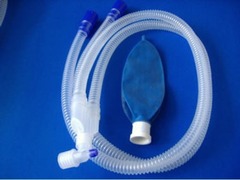
Circle system (rebreathing)

answer
Some of exhaled gases returned (rebreathed) to the patient except for the CO2. Flow of gas through the breathing circuit is circular Oxygen flow rate = 25-50mL/kg/min.
question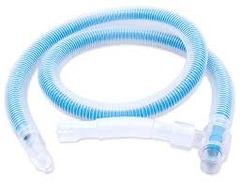
Universal F Circuit (rebreathing)

answer
Some of exhaled gases returned (rebreathed) to the patient except for the CO2 Flow of gas through the breathing circuit is circular Oxygen flow rate = 25-50mL/kg/min.
question
Closed Rebreathing circuit
answer
All exhaled gases remain in circuit
question
Semi-closed
answer
Some gases remain, others out scavenger
question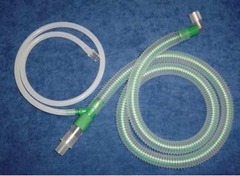
Bain (non-rebreathing)

answer
Little to no exhaled gas returned to the patient Less resistance to air movement than rebreathing system
question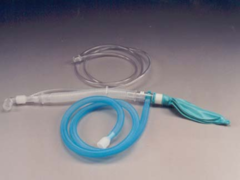
Modified Jackson-Rees (non-rebreathing)

answer
Same information as for Bain but not a coaxial system Oxygen flow rate = 200-300mL/kg/min.



